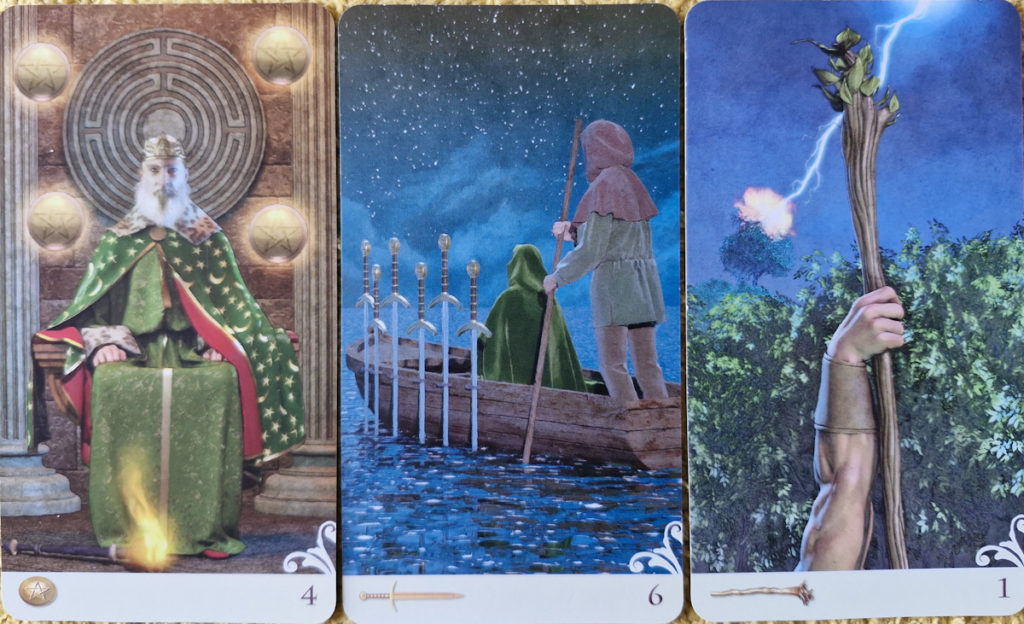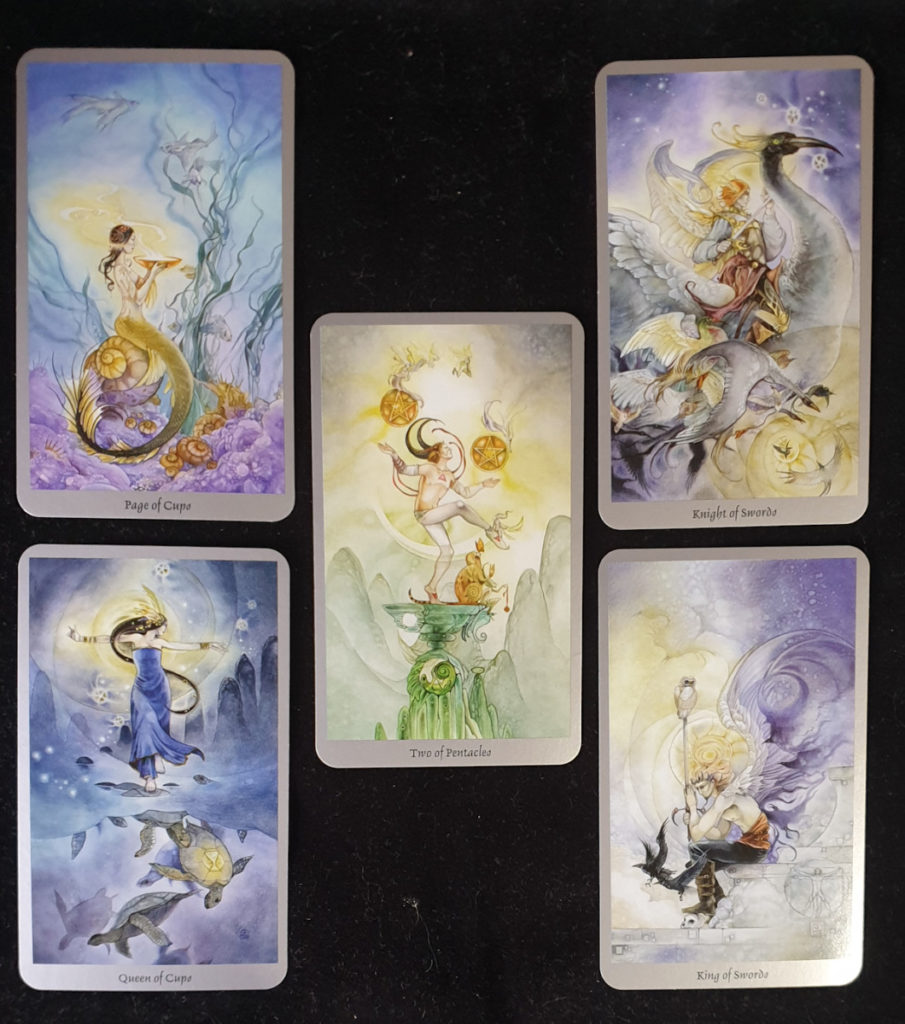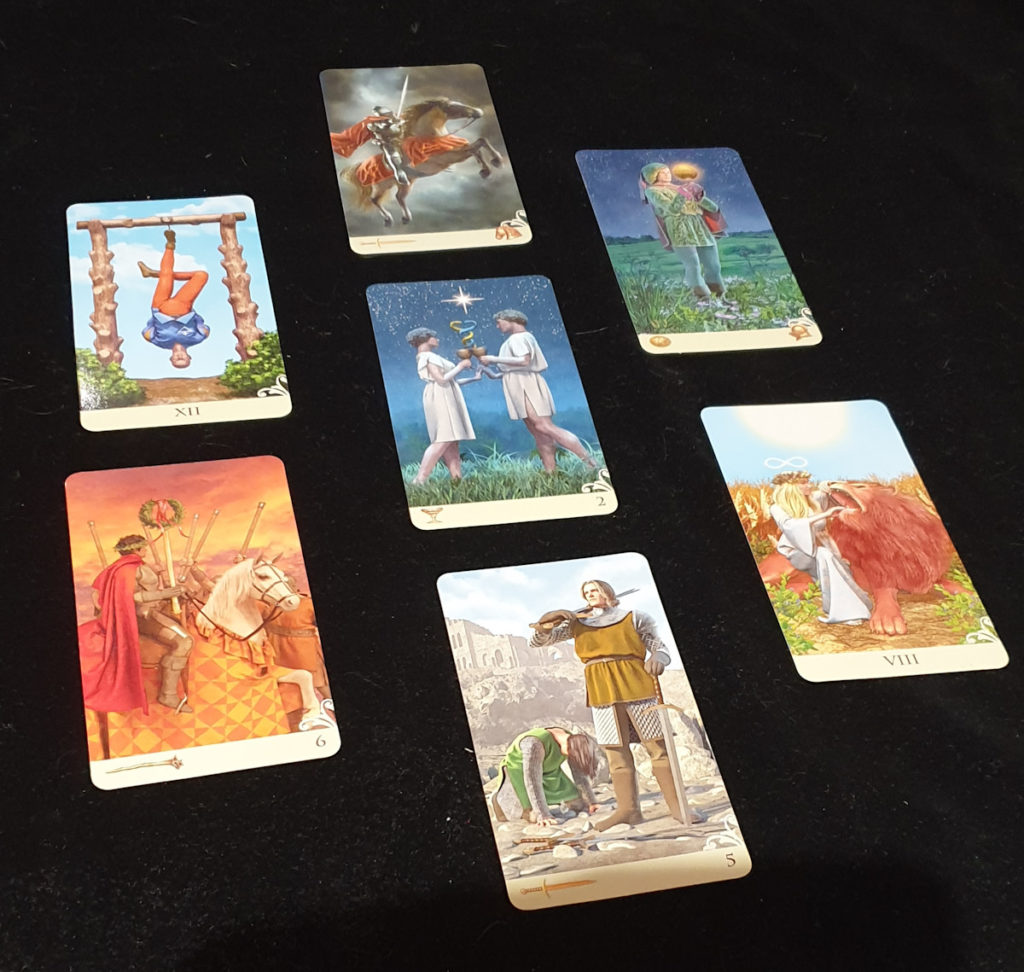When I started learning to read tarot, I thought I needed to know all the spreads. I purchased books of spreads and attempted to memorize them at the same time that I was trying to memorize all the card meanings. Confusion was me. Over the years, experience taught me that I only needed a core stable of top five tarot spreads that would cover all the needs of my clients.
Image: The Pagan Otherworlds Tarot. Photo by author.
The most important thing I learned about tarot spreads is that they are infinitely adaptable. If you don’t need one particular position meaning, swap it out for one that is more relevant. The cards don’t care. Just hold your intention clearly in mind before you draw the cards.
Let’s take a detailed look at my favourite spreads and have a little play with them.
1. The One-Card Reading
Often overlooked, the one-card reading is the epitome of simplicity. Readers may often want to impress with complex spreads, but you can’t beat the one-carder for answering a direct question. Each card has so many layers of meaning that a good reader can get a ton of information out of it. I use it on my website for free readings and, even after all these years, there is still more a single card can teach me.
When and Why to Use a One-card Spread
- A. When you need a fast answer. One card will give you a quick and concise answer. Beware, though, sometimes it will answer a completely different question, often because it is more important to the seeker. You simply have to offer the message.
- B. The one-card spread can give you the opportunity for daily reflection. Use for clarity and guidance. Perhaps include it in your journal at the end of the day.
- C. Use it for an ‘open’ reading on a single issue. Instead of asking a question, just hold the situation in mind and see what a card can tell you. Good when you need clarity on a pressing concern.
- D. When you want to see the general energy around you.
Example of a One-Card Reading
You’re contemplating a change of job. Is this the right time? Draw a single card to give a yes or no answer.
The card is the Two of Pentacles. This suggests you need to spend a little more time weighing up the decision process. So I would say it’s a guarded ‘yes’. If it had been the Ace of Wands or Swords, then it’s a straightforward ‘yes’. Had it been, say, Death, it says a change is coming whether you like it or not.
For more information on what I think are the yes/no cards, check out this article Be aware that it is mainly for relationship questions.
2. Three-Card, Past-Present-Future Guidance
Another straightforward spread that is mostly self-explanatory. Lay out the three cards horizontally: 1, 2, 3.
- Card 1. Provides information and insights into how the situation in question has unfolded.
- Card 2. Gives a snapshot into the current state of affairs. It might be a Court Card that shows who is influential in the situation.
- Card 3. Shows you the way forward. Depending on the card, it might encourage you, warn you, or offer food for thought on how to proceed.
When and Why to Use a Three-Card PPF Spread
- A. When you need more information than one card can provide.
- B. When you want to gain clarity about what led up to the present circumstances.
- C. When you need to see a way out of the situation.

Three-card spread using the ViceVersa Tarot. Photo by author.
Example of a Three-Card Reading
Taking our change of job/career question, let’s say you draw the Four of Pentacles, the Six of Swords, and the Ace of Wands.
The past card, Four of Pentacles, shows a pattern of reluctance to let go, perhaps indicating that you have felt more comfortable ‘with the devil you know’, hindering your conflicting desire to make a change.
The Six of Swords in the present position indicates that you are ready to move on, albeit cautiously. As swords represent ‘head-stuff’, you may still be in the mental transition stage.
The Ace of Wands as future guidance, heralds a lighting of your passion. You will see an opportunity that you cannot resist. It tells you to be ready to take inspired action.
Don’t forget, the three-card spread is extremely adaptable. You may not need the past position because it is irrelevant. So maybe go for: 1. Present. 2. Future if I do that. And 3. Future if I do this.
The three-card spread is invaluable when you need a concise yet holistic view of a situation and suggestions about how to get through it. I find it so useful—it’s like looking through a keyhole at the flow of time. Helps me to focus on what is important.
3. Five-Card Relationship Spread
This is the spread I use whenever two points of view are necessary. Doesn’t need to be a romantic relationship; it can be anything that involves two people. Essentially it sheds light on relationship dynamics, whether it be spouses, friends, parent/child, or boss/employee.
Lay the cards in a square formation with card five in the middle.
- Card 1. Person A. Shows what they bring to the situation, energy, traits, or actions.
- Card 2. Person B. Same as above.
- Card 3. The bridge. Shows challenges (differences) or shared views. Depends on the cards that shows up.
- Card 4. Advice for Person A.
- Card 5. Advice for Person B.
One thing I will say here is that the reader must always consider the ethics of reading the cards for someone who hasn’t consented. If you aren’t sure, focus on the person who has asked for the reading and keep it general so they can draw their own conclusions.

Five-card reading using the Shadowscapes Tarot. Photo by author.
Example of Five-Card Relationship Reading
Laura is concerned about her best friend, Jayne. Jayne has seemed a little distant and less interested in spending time with Laura over the past two months. She’s asked for a reading to give some clarification. Does she need to be worried or should she let it go until Jayne comes around in her own time?
- Card 1. Laura – Page of Cups. Reveals that Laura feels like the ‘child’ of the friendship, as though she relies on Jayne to take the lead. She may also be experiencing (over) sensitivity.
- Card 2. Jayne – Knight of Swords. Shows that Jayne is focused on a personal goal that doesn’t involve anyone else. She has had to prioritize her time.
- Card 3. Bridge – Two of Pentacles. Both friends must be flexible and adapt to changing circumstances. If Jayne is unable to do this because of her commitments, then it will be down to Laura to accommodate her friend’s current challenges.
- Card 4. Advice for Laura – Queen of Cups. This card suggests Laura try to be empathic and be there, supportively, if and when Jayne expresses her concerns.
- Card 5. Advice for Jayne – King of Swords. The wise King tells Jayne to be clear in her communications and to do her best to see things from Laura’s point of view. As the friendship is valuable to both, she needs to be considerate of her friend’s feelings.
This five-card relationship spread is so useful when dealing with any two-person situation. Keep it in your tarot armoury for future use.
4. The Seven-Card Wheel of the Year Spread
This is an alternative to the traditional 12-card year-ahead spread. It uses one card for each period of two months plus an extra overview card. Lay it in a circle of six cards beginning at a one-o’clock position. Place the last card in the centre.
Each card around the circle represents two months so if this spread is used at the beginning of the year, card one would be January/February. However, you can use the spread at any time of the year so card one can be the current and next month.
The cards will show the general energy around the seeker at these times. Bear in mind that the time periods are fluid, so what they show can ‘leak’ across the months. They do for me anyway.
Depending on what cards show up, you might see situations (Minor Arcana), people (Court Cards), or influences/life lessons/themes (Major Arcana).

Seven-card spread. ViceVersa Tarot. Photo by author.
Sample Interpretations for a Wheel of the Year Reading
Let’s say the Magician turns up as the first card representing January and February. As it is a Major Arcana, the seeker should be encouraged to research what the card means. They will learn they have all the willpower and inner resources they need to make a new start with some aspect of their life. Focusing on what they want positively will make it happen.
Perhaps the central card is the Ace of Cups. This shows the overall energy surrounding the seeker. In this case, it is love. They should hold this love energy in their whole being and it will stand them in good stead as the year unfolds.
You get the idea.
I tell my clients to remember to check back on the reading throughout the year. It’s interesting to see in what ways the cards accurately predict what’s coming, even when it’s different from expectations. I find the cards are always right; it’s the reader who sometimes gets it wrong. That’s a terrible admission, but hey ho!
5. The 10-Card Celtic Cross
The good old Celtic Cross ranks as my joint favourite spread along with the one-card readings. The CC is just so flexible.
It was created by the occultist, A.E. Waite, who also commissioned the images of the Rider-Waite tarot deck from Pixie Colman-Smith. I have a comprehensive article about this spread here: Mastering the Celtic Cross Tarot Spread: A Comprehensive Guide.
The cards are laid out in the form of a cross with the last four cards at the right-hand side, bottom to top, forming the staff.
There is a consensus on the positional meanings but, as mentioned, it is infinitely flexible and you can change the meanings as long as you are clear on what you expect.
- Card 1. Heart – represents the central issue or question at the core of the reading. It sets the stage for the entire spread. In a general, open reading, I don’t specify any situation.
- Card 2. Crossing – placed over the first, symbolizes the challenges or obstacles hindering the seeker.
- Card 3, Foundation – below the first two cards. Delves into the root of the matter, shedding light on its origins. Will usually show a distant past event or turning point for the seeker.
- Card 4. Recent Past – Placed to the left of cards 1 and 2., It offers insights into events or influences from the recent past that have led to the current circumstances. These events may still be happening now.
- Card 5. Higher Self – positioned above the first cards, it signifies the higher self or aspirations related to the question. It reflects the spiritual aspect of the matter.
- Card 6. Immediate Future – placed to the left of the first two. It provides a glimpse into what may unfold in the immediate future, offering guidance for upcoming decisions. Look carefully and you will see a timeline made up of cards 4, 1 & 2, and 6.
- Card 7. Seeker’s influence – at the base of the staff, this card represents the seeker’s thoughts, actions, attitudes, or energies that affect the situation.
- Card 8. External factors – other people with influence. Positioned above card 7, this card delves into the inner thoughts, feelings, or attitudes of others.
- Card 9. Wildcard – sits above 8. It may offer further insight or advice, depending on what card turns up here.
- Card 10. Outcome – Above 9. The final card serves as a culmination of the entire spread, providing a glimpse into the potential outcome or resolution. Often, it will show the outcome if nothing changes. Sometimes, I will place another card next to it if I feel it is too vague or is a Court card.
I won’t include a sample reading of the Celtic Cross here as I have already covered it in the linked article above. I encourage any new tarot reader to use the CC once they have confidence in using the smaller spreads. It will become your go-to in any complex situation.
Note that sometimes, a Celtic Cross reading might take a whole year or more to reflect in real life. As with the Wheel spread, it’s a good idea to revisit and get updates from your client after a few months.
Quick Round Up of all Top Five Tarot Spreads
- The one-card spread is simplicity itself. Yet one single card is able to provide layers of meaning. Use when a quick answer is required.
- The three-card past, present, and future guidance spread provides a broader perspective and may show the seeker how things came about and where they are going.
- The five-card relationship spread reveals the dynamics between two people and offers advice on how to resolve differences.
- The seven-card wheel of the year spread connects the seeker to the turning year and provides a holistic overview of the energies coming at them during the coming months.
- The more complex Celtic Cross – a 10 card reading that comprehensively reflects the current situation, past influences, people and outcome. A staple of every tarotist’s spread library. Reserve it for in-depth readings and don’t expect to interpret it fully in a few minutes. Devote at least an hour to its interpretation and don’t forget to follow up.
These layouts show how diverse the tarot can be. And these are just my favourite top five tarot spreads. Be sure to explore lots of others to see which ones work best for you.
Further Reading
Power Tarot by Trish MacGregor and Phyllis Vega (Amazon affiliate link) was my first tarot spread book. It’s looking a bit tatty now but I still turn to it when looking for something different. It starts with a comprehensive overview of tarot, including interpretations of each card. Then provides 100 spreads from one-card up to the 24-card double horoscope spread. Highly recommended.
The Complete Book of Tarot Spreads by Evelin Burger and Johannes Fiebig (Amazon affiliate link) provides an extensive collection of tarot spreads, including traditional and contemporary options.
- Three Spring Tarot Spreads


Dear Troi, excellent, thank you, Ed